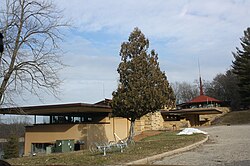
Annunciation Greek Orthodox Church in Wauwatosa, Wisconsin, United States, was designed by architect Frank Lloyd Wright in 1956, and completed in 1961. It is listed on the National Register of Historic Places. The church is one of Wright's last works; construction was completed after his death. The design is informed by traditional Byzantine architectural forms, reinterpreted by Wright to suit the modern context. The church's shallow scalloped dome echoes his Marin County Civic Center.

Edwin H. Cheney House (1903) located in Oak Park, Illinois, United States, was Frank Lloyd Wright's design of this residence for electrical engineer Edwin Cheney. The house is part of the Frank Lloyd Wright–Prairie School of Architecture Historic District. A brick house with the living and sleeping rooms all on one floor under a single hipped roof, the Cheney House has a less monumental and more intimate quality than the design for the Arthur Heurtley House. The intimacy of the Cheney house is due to the building not being a full story off the ground and being sequestered from the main street by a walled terrace. In addition, its windows are nestled between the wide eaves of the roof and the substantial stone sill that girdles the house.
The Quintin Blair House in Cody, Wyoming, United States, was designed by Frank Lloyd Wright and built 1952–1953. The house is an example of Wright's "natural house" theme, emphasizing close integration of house and landscape. It is the only Wright building in Wyoming.
The Rayward–Shepherd House, also known as Tirranna and as the John L. Rayward House, is a home in New Canaan, Connecticut originally built in 1955 to a design of renowned architect Frank Lloyd Wright. Commissioned by Joyce and John Rayward, the home was expanded to a design of Wright’s successor firm, Taliesin Associates by subsequent owner Herman R. Shepherd after his purchase in 1964.

The Charles L. and Dorothy Manson home is a single-family house located at 1224 Highland Park Boulevard in Wausau, Wisconsin. Designated a National Historic Landmark, it was listed on the National Register of Historic Places on April 5, 2016, reference Number, 16000149.

The Frederick C. Bogk House is Frank Lloyd Wright's only single-family residential project in Milwaukee, Wisconsin. Bogk was an alderman and secretary-treasurer of the Ricketson Paint Works. This house embodies Wright's prairie style elements into a solid-looking structure that appears impregnable.

Duey and Julia Wright House is a Frank Lloyd Wright designed Usonian home that was constructed on a bluff above the Wisconsin River in Wausau, Wisconsin in 1958. Viewed from the sky, the house resembles a musical note. The client owned a Wausau music store, and later founded the broadcasting company Midwest Communications through his ownership of WRIG radio. The home also has perforated boards on the clerestories "represent the rhythm of Beethoven's Fifth Symphony Allegro con brio first theme." A photograph showing the perforated panels is in the web page on the National Register application.

The John D. Haynes House is a house in Fort Wayne, Indiana, designed by Frank Lloyd Wright. The house is a small and modest Usonian design in glass, red tidewater cypress, and Chicago Common Brick on a red concrete slab.

The A. D. German Warehouse is a Frank Lloyd Wright designed Mayan Revival warehouse that was constructed in Richland Center, Wisconsin in 1921. Wright was born in Richland Center in 1867. The building is on the National Register of Historic Places.

Tan-y-Deri, is also known as the Andrew T. Porter Home and the Jane and Andrew Porter Home. Jane Porter (1869-1953) was the sister of architect Frank Lloyd Wright. The home was commissioned from Wright in 1907, with Jane and Andrew Porter (1858-1948) moving in with their children James (1901-1912) and Anna (1905-1934) by late January 1908. The home stands in a valley in the town of Wyoming, Wisconsin. This valley was originally settled by the Lloyd Joneses, who were the family of Wright and his sister's mother. The Lloyd Joneses were originally from Wales and, as a result of this heritage, Wright chose a Welsh name for the Porter home: “Tan-y-deri” is Welsh for “Under the oaks”.

The Unity Chapel is located in town of Wyoming in Iowa County, Wisconsin United States. It was added to the National Register of Historic Places in 1974.
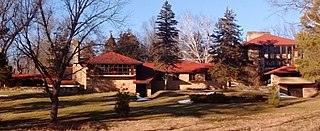
The Hillside Home School II was originally designed by architect Frank Lloyd Wright in 1901 for his aunts Jane and Ellen C. Lloyd Jones in the town of Wyoming, Wisconsin. The Lloyd Jones sisters commissioned the building to provide classrooms for their school, also known as the Hillside Home School. The Hillside Home School structure is on the Taliesin estate, which was declared a National Historic Landmark in 1976. There are four other Wright-designed buildings on the estate : the Romeo and Juliet Windmill tower, Tan-y-Deri, Midway Barn, and Wright's home, Taliesin.
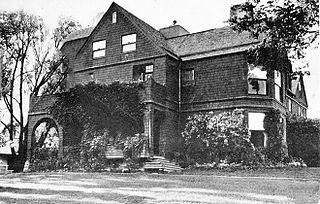
Hillside Home School I, also known as the Hillside Home Building, was a Shingle Style building that architect Frank Lloyd Wright designed in 1887 for his aunts, Ellen and Jane Lloyd Jones for their Hillside Home School in the town of Wyoming, Wisconsin. The building functioned as a dormitory and library. Wright had the building demolished in 1950.
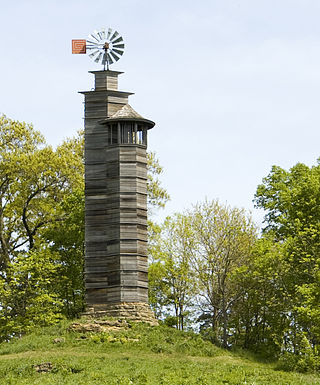
The Romeo and Juliet Windmill is a wooden structure designed by architect Frank Lloyd Wright in the town of Wyoming, Wisconsin. The building is on the Taliesin estate and was declared a National Historic Landmark in 1976.
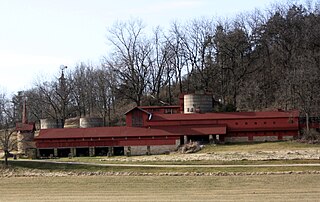
Midway Barn was designed by architect Frank Lloyd Wright for farming on his Taliesin estate in the town of Wyoming, Wisconsin. The building was designated a National Historic Landmark in 1976.

The Wyoming Valley School is a historic school building designed by architect Frank Lloyd Wright in the town of Wyoming in Iowa County, Wisconsin, United States. It is listed on the National Register of Historic Places.

William G. Fricke House is a home by American architect, Frank Lloyd Wright, in Oak Park, Illinois, United States. Fricke commissioned the home in 1901 and it was finished the next year. Wright used elements in the building that would appear in his Prairie style homes: a high water table, horizontal banding, overhanging eaves, shallow hipped roofs, and an exterior with an expansive amount of stucco. Wright usually emphasized the horizontal in his house designs, but the Fricke house is different by having a three-story tower.

The John C. Pew House, also known as the Ruth and John C. Pew House, is located at 3650 Lake Mendota Drive, Shorewood Hills, Wisconsin. It was designed by American architect, Frank Lloyd Wright in 1938 for research chemist John Pew and his wife, Ruth. Built on a narrow lot, the two-story home steps down the sloping hill to the shore of Madison's Lake Mendota. A home in Wright's Usonian style, the building was meant to be economical: its cost was US$8,750. Construction was supervised by a member of Wright's Taliesin Fellowship, William Wesley "Wes" Peters. Peters said to Wright about the building that, "I guess you can call the Pew house a poor man's Fallingwater." To which Wright was to have replied, "No, Fallingwater is the rich man's Pew House."

The Sidney Bazett House, also known as the Bazett-Frank House, is a Usonian-style home on 101 Reservoir Road in Hillsborough, California, United States, designed in 1939 by American architect Frank Lloyd Wright. Sidney Bazett wrote to the architect that, "With even our meager artistic knowledge,... it was apparent that it would be a shame to have anyone other than Frank Lloyd Wright design our home."

Ocotillo was a temporary camp in Chandler, Arizona designed by American architect Frank Lloyd Wright and constructed in late-January/early-February 1929 by his draftsmen. The camp buildings, made out of wood and canvas, were intended by the architect to provide living and working spaces for himself and his draftsmen while they worked on a project for promoter, hotelier and entrepreneur, Dr. Alexander John Chandler. Chandler allowed Wright to use part of his land on which to construct the camp.
